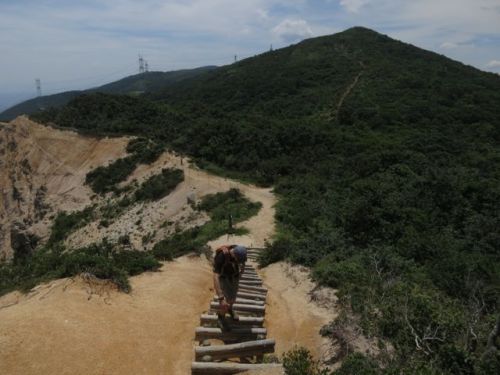My first trip to Akasaka ended in an aborted attempt due to high winds and heavy snow. Time for a much safer approach during the green season. Despite my promise to never go hiking in Kansai in July, here I was aboard the JR Kosei train to Makino station, where Paul D. agreed to accompany me for the 20-minute bus ride to Makino Kogen and the start of the hike. Of course Paul’s train arrived exactly one minute after the bus departed, forcing us to hop in a taxi for the short ride to the hills. I wouldn’t be surprised if the train, bus, and taxi companies are in collusion and deliberately alter the schedule so that transport doesn’t link properly.

Makino looked a lot more tame as we alighted the taxi in the searing heat. Scores of young children sledding down the white slopes were replaced by scrawny octogenarians engaged in fiery games of gateball. We weaved in and out of these grass courts, skirted the edge of a sprawling campground, and hoofed our first steps into the crumbly soil of the mountain. A bit further up the first climb we both realized to our horror that we were indeed on the wrong trail. Instead of the main route up to Akasaka, we were meandering around on some sort of nature trail built to entertain the scores of elementary-aged pupils on their compulsory school excursions. With a little work with the GPS we were able to bushwhack our way onto the proper trail, which weaved its way along the upper edge of a constricted valley. In my first attempt, heavy rain and cloud made this section of trail unforgettable, and there were nothing to do but push on to the first rest point at a sheltered gazebo. This time around, other than the thick humidity, the course was a pleasant stroll through scented pines and towering oaks. We didn’t bother resting at the shelter since we were just warming up, so we pushed on.

The trail dropped to a small stream flowing in a weak trickle down a concrete dam. This joke of a creek was a raging torrent in the winter, flanked on the far end by a headwall of snow towering several meters in height. A gushing fall of frigid water dropped to our feet – any trace of a path was swallowed up by both the water and the heavy snow drifts. Mike, Topher, and I headed to the left, kick-stepping through the debris of an avalanche chute before hitting the ridge a bit higher up the massif. Shocked as I was to discover the real trail climbing the gentler contours to the right of the creek, snaking its way over a series of meandering switchbacks before topping out on the grass-lined ridge.

Here the trail flattened out at a junction on the 80-km long Takashima trail. A trio of electrical towers stood guard, transporting electricity from the nuclear power plants of Fukui over to the step-down transformers lining the shores of Lake Biwa. In our winter attempt, we met the full brunt force of the winds, turning left here along the exposed ridge to the summit of an unmarked peak. Taking a break in the subzero temperatures and whiteout conditions was hardly an option, so we dropped back down into the sheltered valley from which we had ascended. Although we did summit a mountain peak that dreadful afternoon in March, it was not Akasaka, but a higher, unnamed peak a little further north along the snaking ridge. Our honest mistake was turning left at the electrical towers. The real trail veered right here, and it was a simple climb of only 15 minutes to the top of Mt. Akasaka.

Perhaps my winter failure was a blessing in disguise, for Paul and I were rewarded for our efforts with spectacular panoramic views. The summit, however, was completely devoid of shade, threatening to bake us alive in this horrendous late-July heat. What happened to my rule of not climbing in July?

We sought shade on the eastern slopes of the peak and dropped to a small saddle before a short climb to a series of sandstone rock formations, where we lazed in the shadow of a lofty crag. My frozen Aquarius sports drink was now well-thawed and went down easily along with a handful of lightly salted potato chips. Instead of continuing along the trail to the summit of Mikuni and looping back to the bus stop, we retraced our steps – the thought of walking along a paved road for close to two hours to reach the bus stop was something that didn’t feel right in the heat of the afternoon, so we saved time and a bit of energy by keeping to the forest. We did take a bit of a detour once back at the campground to view a scenic waterfall, whose chilly waters kept the heatstroke at bay.

Back at the bus stop, we had mere minutes to spare before the last bus of the day back to Makino station. There would be no time for a bath this time around, and the thought of a hot bath on such a muggy day was nauseating anyway. During the first trip, we spent well over an hour thawing out our limbs in the angelic waters, but in the summer, an ice cream was an acceptable substitution.
Read Full Post »






